France, St. Beat
The next morning I wake up with the strangest feeling that I’m not alone and I sit up to find a squirrel gobbling my nuts! I’d left the window open and a bag of mixed nuts and dried fruit on the window sill. A rather unlikely event I’d agree, but I’m in the Chalet le Chapeau Bleu in St. Beat, a biker friendly Chalet/B&B surrounded by ancient woodland, where’s my air rifle when I need it, bugger!
This place is simply oozing with wildlife and a bird spotters paradise, take your breakfast out on the garden patio and you will be fighting off the blue tits, french tits, robins, moles and herds of nut pilfering squirrels. This is a perfect place to hold up for a couple of nights and explore the area with great roads north, south, east and west. Today I’ll be heading west over Col de PeyresourdeThe Col de Peyresourde (Occitan: Còth de Pèira Sorda) is a mountain pass in the central Pyrenees on the border of the department of Haute-Garonne and Hautes-Pyrénées in France. It is situated on the D618 road between Bagnères de Luchon and Arreau., Port de BielsaPort de Bielsa (or The Port de Balès (or Col de Balès) is a high mountain pass in the central Pyrenees in the department of Hautes-Pyrénées in France. It connects the village of Ferrère (to the north) to that of Bourg-d’Oueil, Haute-Garonne (south-east).
The Port de Balès was featured in the 2007, 2010 and 2012 Tour de France., Col d’AspinCol d’Aspin (Occitan: Còth d’Aspin; 1,489 m.) is a high mountain pass in the French Pyrenees in the department of Hautes-Pyrénées. It connects Sainte-Marie-de-Campan, in the upper Adour valley, with Arreau, on the River Neste.,the famous Col de TourmaletCol du Tourmalet (2,115 m / 6,939 ft) is the highest road in the central Pyrenees in the department of Hautes-Pyrénées in France. Sainte-Marie-de-Campan is at the foot on the eastern side and the ski station La Mongie two-thirds of the way up. Luz-Saint-Sauveur is at the bottom of the western side. and Col du SoulorCol du Soulor (el. 1474 m.) is a high mountain pass in the Pyrenees in France, linking Argelès-Gazost with Arthez-d’Asson. It connects the Ouzom and Arens valleys. A road leaves the pass to the west to reach the higher Col d’Aubisque.
The road over the col is regularly used in the Tour de France cycling race, normally in conjunction with the Col d’Aubisque., but before I get into that I thought I might tell you of where I’m staying and some of the world class roads in this area.
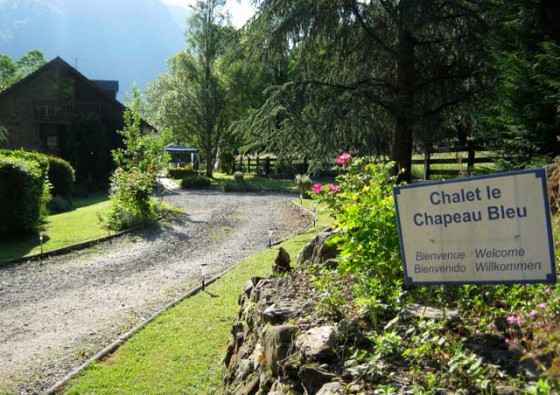
Chalet le Chapeau Bleu in Saint-Beat
Saint-Béat itself is a tiny little town in the Garonne Valley without much to attract the average tourist, but the area is steeped in history. In Roman times it was named Beatus and the area which runs into the Aran Valley was known as “Passus Lupi” (passage of wolves) and was a former stronghold commanding the valley of the Garonne. Its military importance had been nicknamed the “Key of France” as far back as when the Moors controlled Spain as far north as 100km south of here. In WWII is was used by the French resistance to ferry Jews and downed allied pilots out of occupied France. But that’s the thing with France, even seemingly uninteresting places have a hidden history.
But enough of that, lets get stuck into the roads.
Saint-Béat Eastern Loop
Length: 280km
Route: Col de Menté, Col de Portet d’Aspet, Col de la Core, Col de la Crouzette, Col de Portel, Col de Péguère, Col de Port and Col d’Agnès
This takes a solid but relaxed day to cover so you need an fairly early start. It’s a mixed bag of roads starting off with the twisty Col de Mente on the D44 just east of Saint-Béat. This route goes through 8 mid height cols, there are a couple of petrol stations on the way but not many, so top up every chance you get. There are also a couple of small Pyrenean villages to grab a bite or a coffee, don’t forget your camera. I did this route in 2011 and it’s about as pleasant a days riding as you could hope for, either do it as a loop back to Saint-Béat or as a route into Andorra.
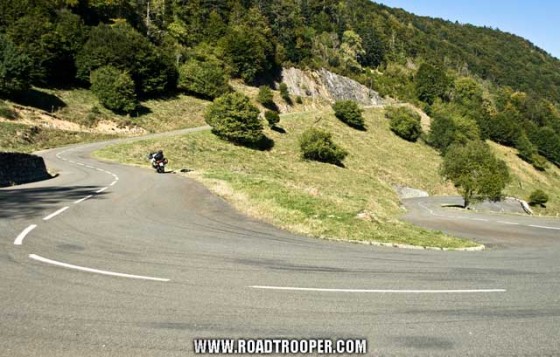
Col de Mente near Saint-Béat
The Southern Saint-Béat 270km Route
Not to be missed and give yourself a full day to enjoy it.
This route runs into Spain and some stunning roads and scenery. The first 65km part of this route along the N230 I admit is a little heavy on traffic and not particularly exciting, however, immediately after turning off onto the N260 the grin factor may permanently damage your face. From the turn off the N230, the N-260 cuts through Aragon’s Mountains of Sis through river cut canyons and forest, keep left after Castejón de Sos you will find a petrol station then keep on N-260 which will lead you into the Ventamillo gorge, much of which rivals Gorge du Verdon except there is little to no traffic.
Aragonese Pyrenees
The gorge of Ventamillo is located at the entrance to the Valley of BenasqueBenasque is a town in the comarca of Ribagorza, province of Huesca, (Spain). It is the main town in the Benasque Valley, located in the heart of the Pyrenees and surrounded by the highest peaks in that range., intersected by the river Ésera and in the historic county of Upper Ribagorza. The N-260, crosses between the villages of Seira and El Run and this road winds it’s way under vertical limestone cliffs following the Rio Ésera, unbelievably 40,000 years ago this gorge was almost 1km under a glacier ice sheet running south from the Aneto massif – one of the highest peaks of the Pyrenees. This gorge is really impressive and leaves you with a difficult choice, either stare at the views or enjoy the swift, smooth twisty N-260, unfortunately you cant do both and hope to return home alive. For me the N-260 is easily one of the best roads in the Aragon Pyrenees, do yourself a favor and don’t pass up the chance of riding her…
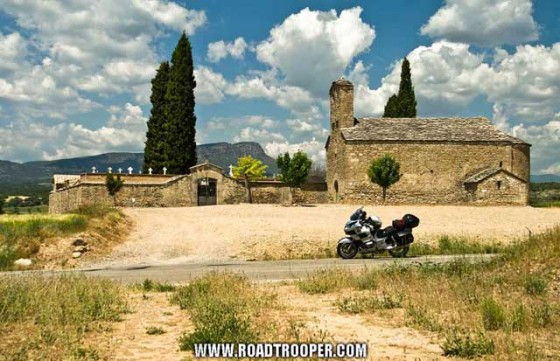
Ermita de la Virgen del Llano de Laguarres, a 13th Century church just outside Capella on the A-1605, Aran Valley, Aragon, Spain
At the town of Campo the N-260 becomes the A-139 and you have a straight run to Graus where you turn off onto another stunning road. But before you do you might just want to check out the truelly ancient (Paleolithic era) small town of Graus and it’s basilica. It’s real easy to pass through this town without a seconds thought, but walk off the main through road into the old town and you will find a real gem, and being one of the northernmost points of the Moors Islamic Spain until 1083. One of Spains greatest heros, El Cid fought the Moors at the battle of Graus, the local history is incredible. It holds a rather typical market here every Monday, but when I say every Monday I mean every Monday since 1588!
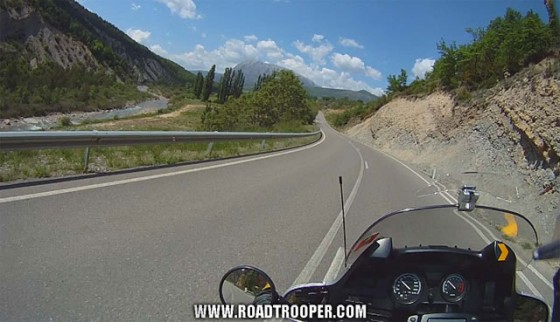
Pyrenees foothills, A-1605, Aran Valley, Aragon, Spain
And even if you speak a little Spanish you will still be lost as many of the locals only speak Aragonese – a language derived from a kind of weird mix of Basque, Catalan and Latin. On September 12-15th is the town festival which is fascinating to see for the local customs, honestly it’s hard to imaging you’re in Spain as the local musicians have their own form of bagpipes and dance in incredible costumes utterly unique in Spain. On the last day in July Graus holds one of the largest BBQ festivals in the world and in the local forests the largest black truffles in the world can be found. Interestingly these are worth more than their own weight in gold! So if you bump into me there next September walking around with a pig on a leash you know what I’m up too!
There are two towns worth visiting off this route, firstly Benasque (north of N-260) an ancient Roman town at the foot of the Maladeta massif (Cursed Mountains) and Ainsa which dates back to 742. In my humble opinion Ainsa can not be missed if you love medeval type towns with restored castle’s and arcaded buildings, but if you want to stay here over night in mid summer then you need to book well in advance as it’s a tourist trap from June- mid Sept.
From Graus take the A-1605 and passing the Ermita de la Virgen del Llano de Laguarres – (a 13th Century church set in an impossibly picturesque landscape) just outside Capella, the road opens up with jaw dropping vistas of the Río Isábena and the looming Pyrenees, this part of the route I described in my previous post (Day 1) and I have gone well out of my way to return here again.
Col Du Portillon Western Route
Length: 275km
Cols: Col Du PortillonThe Col du Portillon (Spanish: El coll de Portilló; elevation 1293 m) is a high mountain pass in the Pyrenees on the border between France and Spain. It connects Bagnères-de-Luchon in France with Bossòst in the Val d’Aran, Spain., Col de Peyresourde, Port de Bielsa, Col d’Aspin, Col du Tourmalet, Col de Soulor, Col d’Aubisque
Col Du Portillon
I’m heading west where my route will firstly take me back into Spain where I can get a tank full of cheap petrol then over Col Du Portillon and back into France. Col Du Portillon is rather indistinct except for more bloody Guardia Civil pirates hiding in a lay-by looking for victims, but luckily this time they didn’t seem interested in me. This col winds through thick forest over into the next valley where I run into Bagnères-de-Luchon, locally called Luchon, it’s celebrated as a fashionable resort for some inexplicable reason, but it’s worth a visit if you need to stretch your legs. The main promenade, the Allées d’Étigny, is a classically pretty avenue planted with lime-trees, at the western end of which is the “Thermes” – hot baths heated by the same tectonic forces that made the Pyrenees, but as far as I’m concerned it’s probably a breeding ground for legionaries disease and foot fungus so I keep on rolling.
The promenade is lined with bars, shops and restaurants and a number of hotels. If you have made it down here with your wife or girlfriend riding pillion she will undoubtedly appreciate you taking an hour off the bike to have a wander around. With all that going on you might wonder why I haven’t stayed here instead of the Chalet le Chapeau Bleu in St Beat, simple answer is that the hotels here have that 1970′s time warp problem so often found in France which does not float my boat, especially with the prices they ask for. Where as I’m guaranteed great value, cold beer, a good old banter over proper home cooked food, a relaxed nights sleep in a comfortable and spotless bedroom, a solid breakfast all in an idyllic setting in le Chapeau Bleu, for me it’s a no-brainer! In fact I am still in contact with a German couple I met over the dinner table there in 2011, you just don’t get that in most hotels…
Col de Peyresourde / Port de Bielsa
From Luchon the grin factor kicks in riding the smooth and swift D618 over Col de Peyresourde, a Tour de France regular in the central Pyrenees linking Luchon to the town of Arreau, right at the top is a little coffee shop selling regional products and a perfect spot to plan your morning caffeine hit before plunging down the hypnotic D618 into Arreau.
Just west of Arreau is the Col d’Aspin, however I’m a history geek so I take a quick detour south to the French town of Aragnouet on the border to Aragon to take a look at the twelfth century Chapelle des Templiers. This fascinating chappel is the only remaining hospital built and run by the Knights of Jerusalem (Templars) who’s misfortune at the hand of King Philip and the Pope gave us Friday the 13th.
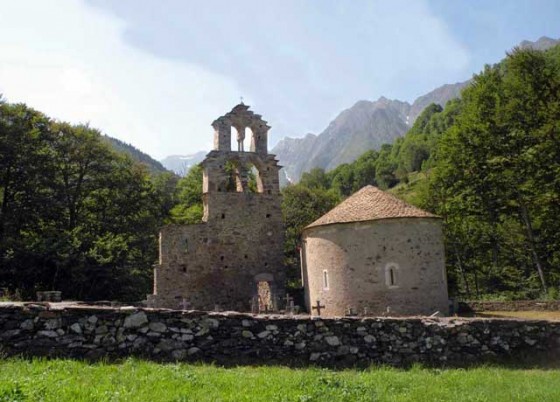
The Knights Templar Chapel & hospital near Port de Bielsa, D118
To this day it’s still part of the legendary pilgrimage route of Santiago de Compostela and a UNESCO World Heritage site.
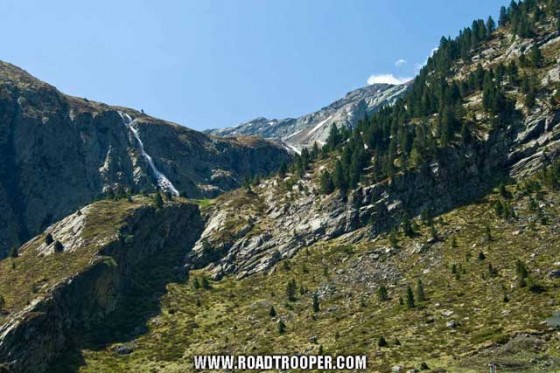
Porte de Bielsa, D118 – D173
Of course if you couldn’t be bothered with that you can continue on the D173 and belt up to the Port de Bielsa Tunnel into Spain, the stunning Alpine type vistas as you close on the summit make the detour well worth it. The town of Bielsa is about 12k south of the border in Spain but not really worth visiting. It was completely destroyed during the Spanish civil war so it’s mainly a modern and not much to look at, but it is a great place to base yourself if you fancy a bit of hiking.
Col d’Aspin
Next port of call is the Col d’Aspin with it’s mix of sweeping curves and tight hairpins with fantastic views at the top looking west towards Col du Tourmalet. The summit of Aspin seems to have a regular bovine infestation of wandering horned milk makers plodding all over the place covering the road in, well – shit!
The worst thing is they show absolutely no regard for traffic as they actually have the right of way. From time to time you will see road signs with “pâturage” written on them with a picture of a cow or a sheep, basically this means there are no fences in the area and farm animals are allowed to roam as they please, if you hit one and hurt it the farmer can claim off you, but of course if you hit a cow at 60mph the farmer is going to be the least of your problems!
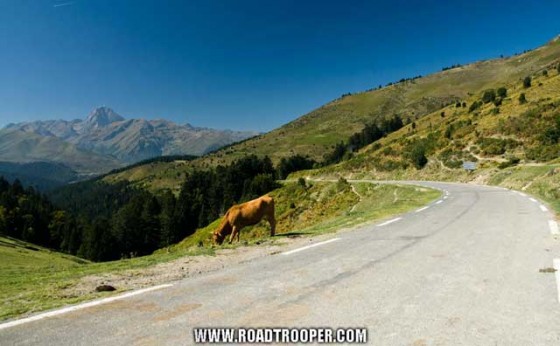
Col d’Aspin looking towards Col du Tourmalet
Col du Tourmalet
From here it’s a relaxing ride through a scenic low valley cutting through small farming villages before the D918 throws off it’s relaxing mood and hurls you into the famous and lofty (2,100m / 7,000ft) Col du Tourmalet, this is the highest pass in the central Pyrenees, and if your a thrill seaking adrenilin junky then this is where you will get an over dose!
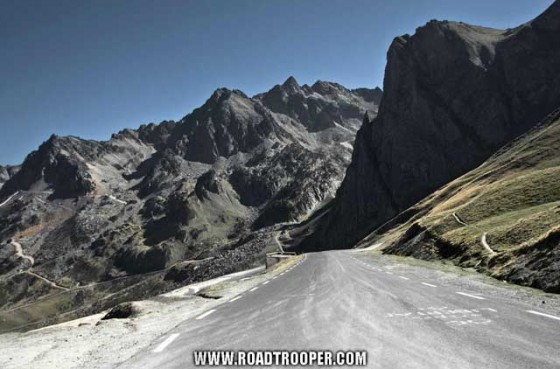
Col du Tourmalet East Ramp
There are a couple of vicious hairpins near the summit as you ride through mountain pastures crawling with llamas which now seem to be the current fashion for the discerning farmer, although don’t be surprised to meet derilict donkeys wondering about holding up the traffic. The view of the road heading down the west side from the top can be a bit of a shock for those who have not been to the Alps, even I felt a growing moist patch in my pants as I inspect the west ramp which plunges down a cliff face for the first part and is littered in inconvient blocks of melting ice and debris.
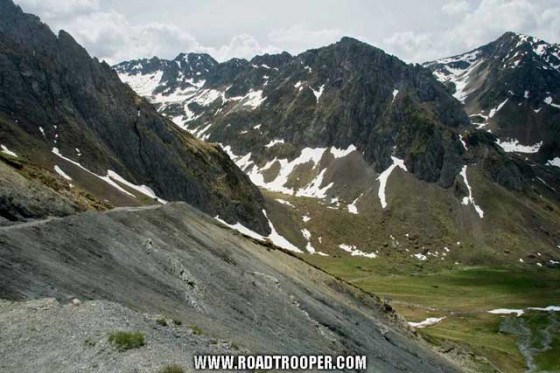
Col du Tourmalet West Ramp
As I made my way down I tried my best not to look over the edge into the abyss, but try as I might I fail as I held my breath and rattled nerves. With a death hold on the handle grips I prayed my way down the slope. You would think 10 years of riding in the Alps would have cured my irrational fear of anything higher than a step ladder by now, but roads like this never fail to make me temporarily religious. I really should see a psychiatrist, but thanking to the recession even the good ones are now working 10 hour shifts in McDonalds.
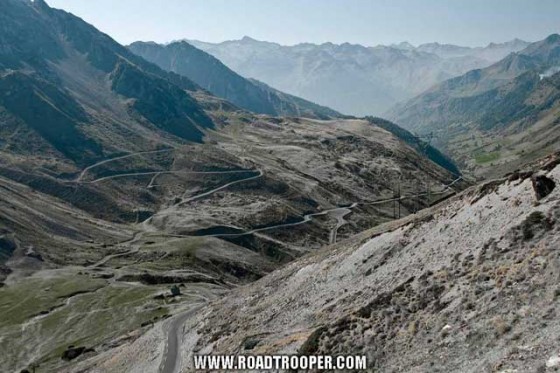
Col du Tourmalet looking west.
I was expecting the Col du Tourmalet to be my highlight of the day and it didn’t disappoint because any ride that necessitates a change of underwear is always going to be memorable, but little did I expect the events of the Col de Soulor and the shocking beauty of Col d’Aubisque would make this trip even more memorable. Still slightly traumatised by Tourmalet my shorts hardly had time to dry out before I ride into the day’s first tropical downpour approaching Soulor.
In a matter of minutes the magical Pyrenean D918 route has turned into another animal completely with day turning to dusk as the weight of impossibly black clouds presses down on me before I’m swallowed in a sheet of water swiftly followed by an ear splitting barrage of thunder and lightning. With Zeus obviously in a seriously pissed off and dark mood I err on the side of caution and decide to wait it out under a 1930′s bus shelter. Within minutes my shelter starts rapidly filling with rain run off from the opposite slope, I’d picked a very bad spot to hide and was quickly forced to get the hell out of there. I waded back to the bike and blindly rode up the road to blessedly find a coffee shop which was it’s self rapidly filling up with an interesting collection of soggy bikers from all corners of Europe.
After half an hour of idle banter with my wet and colourful peers I return to the D918 and make my way up the foot of Col de Soulor only to meet a couple of bikers coming the other direction – both of which shaking their heads and waving me down to go slow. As I ready myself for a likely problem ahead I take the first tight corner of the Soulor section only to find the D918 buried under a layer of debris washed off the slope from the rain storm. I’m not talking about gravel, rocks and sticks here, I’m talking about boulders, trees and a complete lack of D918. It’s simply gone, buried under a foot of mud and part of a forested hillside. And it’s raining again!
As I tried to access how much of the road is missing I walked through the mess to realised it only went as far as the next corner, but there is still no way I’m riding the RT over and through the carnage, and I’m not sure if I’m up for this type of heavy labour on my own. After another 5 minutes pondering the challenges in life and unsuccessfully trying to light a wet cigarette obtained from a sodden packet, I was joyfully reunited by the delegation of colourful and equally bemused Eurobikers I’d previously met in the cafe down the road.
After a quick conversation in shattered English and bastardised French, our team of Dutch, Basque, German, French, Irish and even Norwegian bikers get to work shifting the worst of the apocalyptic disaster that has befallen an undeserving D918, at least enough for us to get our bikes through. In true Brussels fashion we voted to abandon the growing line of cagers to fend for themselves, we would have stayed to help, but not one of the wankers bothered to get out of their warm dry cars to help as we toiled in the rain. Although in hindsight I’ve no doubt our leather clad work crew probably looked like a band of marauding Viking mercenaries that even the Guardia Civil would have thought twice about approaching.
It never ceases to amaze me how quickly and easily complete strangers, from different worlds and speaking different languages can become best mates in a matter of seconds when the only thing they have in common is a love of motorbikes and a buried road to forge. The Norwegian lad even gave me a pack of dry smokes from his pannier before riding off as he had notice me dumping my own soggy tobacco.
And so, with a new sense of comradeship and good will towards humanity (at least the two wheeled kind) I continued my journey in reverence of the D918 that has so far brought me almost as much thrills as the epic D902 along the Route des Grande Alps.
Col d’Aubisque
The remaining ride up Col de Soulor was pleasantly uneventful as I needed to make up some time, I was tired, hungry and wet, oh so very very wet, but I only had one pass left before I headed for my hotel for the evening. As I reached the summit of Soulor and took in my first view of Col d’Aubisque my senses experienced a shock so profound I’d felt nothing like it since riding Col d’Izoard for the first time – the landscape rolling out before me was utterly staggering! I had no strong expectations of this pass and I dont know what I was expecting, but the view before me was not it.
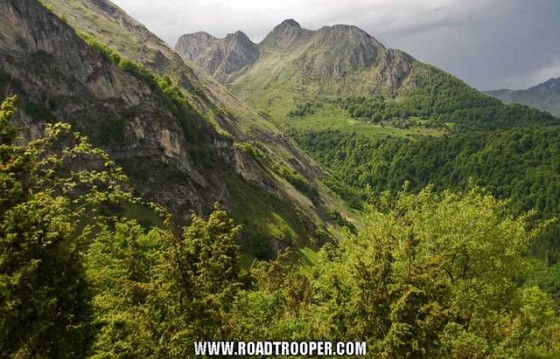
Col d’Aubisque looking east.
The vision ahead onto Col d’Aubisque was like something from Lord of the Rings with sharp pointed peaks claiming the heavens as there domain all carpeted in thick, lush, luminous green forest and grass. Purple blue thunderous storm clouds overhead slashed through with lightening framed a picture forever pounded onto my memory. And the road? Oh that was a real treat as it was literally gouged from a cliff that wound impossibly for 15km above a vertical drop, I honestly think I enjoyed it easily as much as Tourmelet, maybe more. Col d’Aubisque is without doubt a staggering bit of road and an absolute MUST for anyone looking for an unforgettable motorcycle ride, for me I have no shame in admitting it brought a tear of pure joy.
That night I stayed in an old farmhouse hotel deep in tranquil French woodland between the towns of Laruns and Pau called Hotel Les Bains de Secours. About 6km down a country lane this place is blissfully isolated and quiet. The rooms are serviceable, but the reason I chosen to stay was because I’d been tipped off that the restaurant was excellent. The tip was a good one as both the food and the service was excellent as well as a marvelous regional cognac to finish off the meal. This place would be perfect for a couple, but as I was on my own there was no one to stop me indulging myself with a 2nd cognac to help me sleep.
Again I left the windows open to let in the heady scents of lilac, apple blossom and a host of herby fragrance from the kitchens garden as I fell into a deep slumber praying those bloody squirrels would not mount another attack on my diminished bag of dried fruit and nuts.
In my next post I’ll ride possibly one of the greatest biker roads in Europe – the word class Col de Pierre Saint Martin.
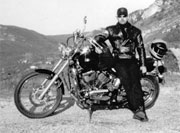







Hi Denis
We`re booked in to Chapeau Bleu for 7 nights end of July this year so your report and routes are perfect timing for us.After that a ride down to Barcelona for 4 nights (keeps the wife happy ) then back to Santander.
) then back to Santander.
2012 rt with wife as Pillion and really looking forward to it. We stayed in Briancon last year and followed your recomendations for the Mont Prorel and had a great stay.
Tony.
Hi Tony,
What can I say, you have the perfect tool for the job with the RT and you’re going to love it. Both sides of the border are fantastic with the roads on the Spanish side the best, smooth and winding – just perfect for the RT.
I’ll have another post up next week with more info on the area, with more routes and plenty of videos to come on the YT channel.
I’m sure you will have a blast
Safe riding,
Denis
Hi Denis
just signed up on your site and spent the last 2 hours reading and looking at amazing pics WOW great site.
Anyway me and an friend are going on our 1st trip abroad on our bikes (after a long time talking about it) we have finally booked it Portsmouth to Bilbo, sail last week in June 7days touring the Pryenees then back to Bilbo and home.
We both have Suzuki DR650se enduro style bikes and i was just wondering if you knew the laws regarding wing mirrors and indicators abroad as we use our bikes for off roading as well as runs to the coast therefore we have neither of these fitted as they don’t last long when your thumping round old quarry’s through the trees.
Also i have read allsorts regarding what we need to carry ie, hi-viz,bulbs,etc the only one i am not sure about is the warning triangle do you need one on a bike.
I have booked a first nights digs in Arrens-Marsous and planned the route along through Pamplona -N240-Jaca-A136 then on the 918 that you mention on your Pryenees tour WOW again that sounds like an epic road and will be looking forward to that.
After that we will just be playing it by ear we have a rough idea where were going but nothing set in stone and will be looking for campsites as we go hopefully we are planning to go all the way across to the east coast and back again but things may change.
Any tips or advice you could give would be great.
Many thanks
Neil
Hi Neil, Sounds like you have a great trip planned..
First off, you’re going to have to put your indicators and mirrors back on as they wont be street legal in Spain without them. I doubt if you would make it past customs before you get you’re bikes impounded, and even if you did the Guardia Civil will bankrupt you with cash on the spot fines out on the road.
As for the hi-vis, you don’t need to wear one but you do need one and must wear it if you break down or get a puncture etc and need to stand on the side of a road or motorway. You will also need spare bulbs and fuses but you do not need to carry a warning triangle, that’s only for cars etc..
You will definetly need; Passport, spare cash for on the spot fines, insurance, road tax, registration docs etc. I’ve more info on this and riding in Spain tips here A Virgin’s Touring Guide
If your going to take in some off roading in the Navarre region etc you must be able to carry plenty of extra water as it can get seriously hot (30C+) and extra fuel if your bikes tank range is under 270km, if you break down or run out of fuel in the remote areas of the parks you’re in big trouble. If you have a laser card DO NOT use it for buying petrol in France or Spain, use only a credit card, but cash is better.
The weather on the French side can be very different from the hot/dry Spanish side especially on the Atlantic coast which has frequent torrential downpours (May/June) so ye might want to take rain gear.
There are plenty of speed and drink driving checks on the Spanish side, even in the middle of nowhere and the fines are cruel. Stick to the speed limits and watch your drinking in the evenings and you will have a blast. The roads on the Spanish side are better, but on DR605’s I don’t think you will care what type of road your on
If you can you should visit the Spanish tourist board offices in the UK or online to get more info on the Pyrenees national parks, in many areas it’s prohibited to use motorbikes on the trails. But there are plenty that you can and even cross the French/Spanish boarders via these tracks/trails which you will love. Just be careful, there are bears and wolves in those hills
I’m planning to get back down there this year myself on a F800GS to find some of these trails. If you find any good ones yourself be sure to let me know so I can upload them for others to find..
Hope this helps, let us know how the trip went when you get back..
Denis
Hi, thanks for all the info will take it all on board and will try and give the Guardia a wide berth if possible.
Just one more question ( sorry bet you get tired of answering questions from touring virgins ) we are looking at fitting bike to bike intercoms just for the crack while riding ie ” look at the tits on that ” but have read elsewhere they are illegal do you know the law on this.
Many thanks for your help and i will try my best to find to nice trails for you to explore.
Thanks
Neil
Hi Neil,
I’m not going to say that intercoms are definitely legal or not as the tossers in Brussels keep coming up with new and increasingly bloody ridiculous laws every couple of days. That said if intercoms are illegal in Spain or elsewhere it’s the first I’ve heard of it! Especially as the bike dealers in Spain are selling them!
I think there may be a little confusion here over in-ear earphones and the actual use of intercoms and SatNavs while riding! In Spain “in-ear” earphones are illegal, or at least it’s a 90€ fine if you’re caught wearing them while connected to an mp3 player as they are regarded as distracting to the rider. So, any bike-to-bike intercom system that uses “in-ear” earphones are illegal, but if it uses speakers fitted within the helmet thats fine.
Speakers fitted within a helmet’s padding are legal, so for example you can have a Bluetooth device (Scala Rider) connected to the speakers so you can listen to your mate commenting on the semi clothed hookers working the roadside or listening to directions from a SatNav. However it’s illegal to operate/adjust ( i.e. press any buttons) a SatNav or intercom while riding a motorcycle.
I have, as yet to hear of any cops anywhere enforcing this as it’s almost impossible to police and I think most cops have better things to be doing anyway. I was stopped by the Guardia Civil 3 or 4 times last year and each time I had in-ear Bluetooth earphones in and they did not seem to care. Either way it’s always a good idea to carry a couple of hundred euro in cash just in case you are unlucky enough to get caught and have a cop enforce this rule.
So, to be clear – it is technically illegal to take your hand off the handlebar of a moving motorcycle to adjust a SatNav or an intercom attached to the side of your helmet, the argument being that you are not in full control of the motorcycle. To turn on/off or adjust the volume of the Scala Rider system for example you need to pull over and stop to do so. This is fair enough and probably common sense, a lot like useing a hands free kit for using a mobile phone while driving a car. However, EU legislation is coming to ban all use of phones, hands free or not while driving, how this will affect intercoms remains to be seen, but they will probably become illegal at some stage.
The traffic laws in Spain are very difficult to give advice on. For the most part all common traffic laws are EU based, but the problem in Spain is that Spain is made up of autonomous states, regions like Murcia, Valencia, Catalonia, Navarre, Castile etc all have slightly different regional laws and their own governments under the central Castile government in Madrid. Even the fines differ from region to region! It’s impossible for a tourist to know each regions specific laws and the cops understand this and will usually ignore infringements like these “if” you are not also driving dangerously like over the speed limit!
Either way, dont be worried. Have extra cash in the unlikely event you do get fined, just use your common sense and ride with the intention of arriving home with your “fine” money intact
Hope this helps..
Denis
Yep that’s roughly how i had interpreted it reading through the endless waffle on the internet.
Think we will go for the intercom as the one we have in mind have speakers that fit inside the helmet and also have vox facility ( weather it works on the bikes is to be seen ) so in theory you don’t need to take your hands of the reigns.
I have emailed the Spanish tourist board to see if they can advise where we are allowed to ride off road failing that we will just follow our noses if we get busted and fined then lesson learnt ( the hard way ).
Anyway its all part of the adventure.
Thanks again for all your advice and will update you on our return.
Cheers
Neil
Hi
Fortuitously I found you site with its wonderful descriptions of the Pyrenees only this week. The week I’ve happened to book my RT, the wife and myself on the Santander ferry for June next year for a 2 or 3 week tour.
I’ve shamelessly copied a number of routes and also booked myself into Chalet le Chapeau Bleu for a few nights at your recommendation.
Nearer the time I may pick your brains some more advice
Regards Mark (from sunny Cornwall)
You copy as may routes as you like there Mark, no shame involved lol… I’m actually just back from the Pyrenees and Chap Bleu, I was up there checking out a few new roads east of Saint-Beat. I’ll be uploading the routes as soon as I’ve written up this years trip report. So check back after thats done as I’ll have a few suggestions for you to ride and perfect for the RT.
If you want to pick my brains feel free, happy to help. Be warned though next May I’m planning to be back on the road early in the month so get in touch before that to be sure I’ll be able to reply. When I’m on the road I like to go back to basics and completly detach myself from TV, Radio, News, FaceBook, Internet, Computer, Mobile Phones, Smart Phones, Ipads this website – the lot, It’ll be just me, the bike and the road, even my wife will have trouble contacting me lol
Denis
Hi Denis
I’d just like to ask what camera do you film all your tours with? I may have missed it in which I’m obviously not very observant!
Thank you for providing some brilliant footage and can’t wait until August 15 for 2+ glorious weeks
Certainly whetted my appetite !!
Graeme
Hi Graeme,
I’m using the Drift HD 170 which I attach to the bike and the Drift HD Ghost (a smaller cam) which I stick to the side of my helmet with a bit of heavy duty velcro…
http://driftinnovation.com/drift-ghost/
Denis
Thanks Denis
I’m off to the NEC in November so I’m sure there must be some deals to be had
Keep these routes coming – the Pyrenees needs exploring if only by me!
Are the any “no go” area ? as in places that should be avoided at all costs r ones that just aren’t pleasant to ride?
What would you say in your opinion, would be the top 5 or even 10, Cols?
Thanks again – you really are superb at what you do!!!
Hi Graeme,
Amazon sometimes have good deal on the Drift cams, every time they produce a new cam the price on older models get much more interesting..
As for a no-go area in the Pyrenees region that’s easy – Andorra! Even 14 years ago it was a bit of a dump, now it’s far worse mostly due to high levels of traffic. Plenty of bikers head to Andorra thinking it’s the highlight of the Pyrenees, trust me – it’s not! The area has become really built up over the last 10 years and is now a complete pain to get through in summer, in winter it’s just a massive ski resort. It’s also a duty free zone which might sound great – until you join the queues at the border controls. My advice is don’t bother going anywhere near Andorra – unless you want to go off-road, but even then you got to be careful unless you have a local guide that speaks Spanish as you can meet armed border guards “Guardia Civil” even on a seemingly deserted mountain and especially in the middle of no where.
As for a list of passes not pleasant to ride well thats a tough one, beauty is in the eye of the beholder and all that, also what type of biking you’re into etc. But here are a list of my favorite cols/ports starting from east to west and in no particular order as I love ‘em all.. This is of course only the tip of the iceberg as there are so many great roads that wind up into the Pyrenees that dead end at ski resorts. Then on the Spanish side there are loads of amazing canyons and roads that aren’t even on any maps, especially in the national parks like the Bardenas Real south west of Pamplona. I’ve been riding the Pyrenees for years and I’ve still plenty of exploring to do so forget about seeing it all in one trip
Check out my YouTube Channel as I’ve got many of these passes on there and I’ll be uploading more soon..
Col d’Orgambidé
Col d’Haritzcurutche
Col de BurdinKurutcheta
Col d’Orgambidesca
Port de Larrau
Col de la Pierre St Martin
Col d’Aubisque
Cirque de Troumouse
Col du Tourmalet
Col de Bielsa
Col d’Agnes
Port de Lers
Enjoy,
Denis
you just get better and better Denis, thank you for that
Carcassonne
I’ll keep viewing and login the interesting bits – I’ve until Auust ’15 to et sorted
cheers Denis